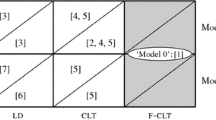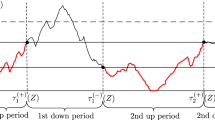Abstract
We review functional central limit theorems (FCLTs) for the queue-content process in a single-server queue with finite waiting room and the first-come first-served service discipline. We emphasize alternatives to the familiar heavy-traffic FCLTs with reflected Brownian motion (RBM) limit process that arise with heavy-tailed probability distributions and strong dependence. Just as for the familiar convergence to RBM, the alternative FCLTs are obtained by applying the continuous mapping theorem with the reflection map to previously established FCLTs for partial sums. We consider a discrete-time model and first assume that the cumulative net-input process has stationary and independent increments, with jumps up allowed to have infinite variance or even infinite mean. For essentially a single model, the queue must be in heavy traffic and the limit is a reflected stable process, whose steady-state distribution can be calculated by numerically inverting its Laplace transform. For a sequence of models, the queue need not be in heavy traffic, and the limit can be a general reflected Lévy process. When the Lévy process representing the net input has no negative jumps, the steady-state distribution of the reflected Lévy process again can be calculated by numerically inverting its Laplace transform. We also establish FCLTs for the queue-content process when the input process is a superposition of many independent component arrival processes, each of which may exhibit complex dependence. Then the limiting input process is a Gaussian process. When the limiting net-input process is also a Gaussian process and there is unlimited waiting room, the steady-state distribution of the limiting reflected Gaussian process can be conveniently approximated.
Similar content being viewed by others
References
J. Abate, G.L. Choudhury and W. Whitt, Calculation of the GI/G/1 waiting time distribution and its cumulants from Pollaczek's formulas, Arch.Elektronik Ubertragungstechnik 47 (1993) 311–321.
J. Abate, G.L. Choudhury and W. Whitt, Waiting-time tail probabilities in queues with long-tail service-time distributions, Queueing Systems 16 (1994) 311–338.
J. Abate and W. Whitt, Numerical inversion of Laplace transforms of probability distributions, ORSA J.Comput. 7 (1995) 36–43.
J. Abate and W. Whitt, Explicit M/G/1 waiting-time distributions for a class of long-tail servicetime distributions, Oper.Res.Lett. 25 (1999) 25–31.
M. Abramowitz and I.A. Stegun, Handbook of Mathematical Functions (National Bureau of Standards, Washington, DC, 1972).
R.G. Addie and M. Zukerman, An approximation for performance evaluation of stationary single server queues, IEEE Trans.Commun. 42 (1994) 3150–3160.
P. Barford and M. Crovella, Generating representative Web workloads for network and server performance evaluation, in: Proc.of 1998 ACM Sigmetrics (1998) pp.151–160.
A.W. Berger and W. Whitt, The Brownian approximation for rate-control throttles and the G/G/1/C queue, J.Discrete Event Dyn.Systems 2 (1992) 7–60.
J. Bertoin, L´evy Processes (Cambridge Univ.Press, Cambridge, UK, 1996).
P. Billingsley, Convergence of Probability Measures (Wiley, New York, 1968).
N.H. Bingham, Fluctuation theory in continuous time, Adv.in Appl.Probab. 7 (1975) 705–766.
L. Bondesson, Generalized Gamma Convolutions and Related Classes of Distributions and Densities (Springer, New York, 1992).
A.A. Borovkov, Some limit theorems in the theory of mass service, II, Theory Probab.Appl. 10 (1965) 375–400.
O.J. Boxma and J.W. Cohen, The M/G/1 queue with heavy-tailed service time distribution, IEEE J.Selected Areas Commun. 16 (1998) 749–763.
O.J. Boxma and J.W. Cohen, Heavy-traffic analysis for the GI/G/1 queue with heavy-tailed distributions, Queueing Systems 33 (1999) 177–204.
O.J. Boxma and J.W. Cohen, The M/G/1 queue: Heavy tails and heavy traffic, in: Self-Similar Network Traffic and Performance Evaluation, eds.K. Park and W. Willinger (Wiley, New York, 2000) to appear.
M. Bramson, State space collapse with application to heavy traffic limits for multiclass queueing networks, Queueing Systems 30 (1998) 89–148.
D.Y. Burman and D.R. Smith, An asymptotic analysis of a queueing system with Markov-modulated arrivals, Oper.Res. 34 (1986) 105–119.
H. Chen and A. Mandelbaum, Stochastic discrete flow networks: diffusion approximations and bottlenecks, Ann.Probab. 19 (1991) 1463–1519.
H. Chen and A. Mandelbaum, Leontief systems, RBVs and RBMs, in: Proc.Imperial College Workshop on Applied Stochastic Processes, eds.M.H.A. Davis and R.J. Elliott (Gordon and Breach, New York, 1991).
J. Choe and N.B. Shroff, A central limit theorem based approach for analyzing queue behavior in high-speed networks, IEEE/ACM Trans.Networking 6 (1998) 659–671.
J. Choe and N.B. Shroff, On the supremum distribution of integrated stationary Gaussian processes with negative linear drift, Adv.in Appl.Probab. 31 (1999) 135–157.
J.W. Cohen, Some results on regular variation for distributions in queueing and fluctuation theory, J.Appl.Probab. 10 (1973) 343–353.
J.W. Cohen, The Single Server Queue, revised ed.(North-Holland, Amsterdam, 1982).
J.W. Cohen, A heavy-traffic theorem for the GI/G/1 queue with a Pareto-type service time distribution, Special issue dedicated to R.Syski of J.Appl.Math.Stochastic Anal. 11 (1998) 247–254.
G. Doetsch, Introduction to the Theory and Application of the Laplace Transformation (Springer, New York, 1974).
S.N. Ethier and T.G. Kurtz, Markov Processes, Characterization and Convergence (Wiley, New York, 1986).
W. Feller, An Introduction to Probability Theory and its Applications, Vol.II, 2nd ed.(Wiley, New York, 1971).
K.W. Fendick, V.R. Saksena and W. Whitt, Dependence in packet queues, IEEE Trans.Commun. 37 (1989) 1173–1183.
H. Furrer, Z. Michna and A. Weron, Stable Lévy motion approximation in collective risk theory, Insurance: Math.Econom. 20 (1997) 97–114.
D.P. Gaver and P.A. Jacobs, Waiting times when service times are stable laws: Tamed and wild, in: Advances in Applied Probability and Stochastic Processes, liber amicorium J. Keilson, eds.J.G.Shanthikumar and U.Sumita (Kluwer, Norwell, MA, 1999).
P.W. Glynn and W. Whitt, Ordinary CLT and WLLN versions of L = λW, Math.Oper.Res. 13 (1988) 674–692.
B.V. Gnedenko and A.N. Kolmogorov, Limit Distributions for Sums of Independent Random Variables, revised ed.(Addison-Wesley, Reading, MA, 1968).
M.G. Hahn, Central limit theorems in D[0, 1], Z.Wahrsch.verw.Geb. 44 (1978) 89–101.
J.M. Harrison, Brownian Motion and Stochastic Flow Systems (Wiley, New York, 1985).
J.M. Harrison and M.I. Reiman, Reflected Brownian motion on an orthant, Ann.Probab. 9 (1981) 302–308.
D.L. Iglehart and W. Whitt, Multiple channel queues in heavy traffic, I, Adv.in Appl.Probab. 2 (1970) 150–177.
D.L. Iglehart and W. Whitt, Multiple channel queues in heavy traffic, II: Sequences, networks and batches, Adv.in Appl.Probab. 2 (1970) 355–369.
J. Jacod and A.N. Shiryaev, Limit Theorems for Stochastic Processes (Springer, New York, 1987).
O. Kella and W. Whitt, Diffusion approximations for queues with server vacations, Adv.in Appl.Probab. 22 (1990) 706–729.
O. Kella and W. Whitt, Useful martingales for stochastic storage processes with Lévy input, J.Appl.Probab. 29 (1992) 396–403.
O. Kella and W. Whitt, Stability and structural properties of stochastic storage networks, J.Appl.Probab. 33 (1996) 1169–1180.
D.P. Kennedy, Limit theorems for finite dams, Stochastic Process.Appl. 1 (1973) 269–278.
J.F.C. Kingman, The single server queue in heavy traffic, Proc.Cambridge Philos.Soc. 57 (1961) 902–904.
J.F.C. Kingman, On queues in heavy traffic, J.Roy.Statist.Soc.Ser. B 24 (1962) 383–392.
C. Knessl and J.A. Morrison, Heavy traffic analysis of data handling system with multiple sources, SIAM J.Appl.Math.51 (1991) 187–213.
T. Konstantopoulos and S.-J. Lin, Macroscopic models for long-range dependent network traffic, Queueing Systems 28 (1998) 215–243.
T. Konstantopoulos, G. Last and S.-J. Lin, On stationary reflected Lévy processes, University of Texas at Austin (1999).
T.G. Kurtz, Limit theorems for workload input models, in: Stochastic Networks: Theory and Applications, eds.F.P. Kelly, S. Zachary and I. Ziedins (Oxford Univ. Press, Oxford, UK, 1996) pp.119–139.
H.J. Kushner and L.F. Martins, Numerical methods for controlled and uncontrolled multiplexing and queueing systems, Queueing Systems 16 (1994) 241–285.
H.J. Kushner, J. Yang and D. Jarvis, Controlled and optimally controlled multiplexing systems: A numerical exploration, Queueing Systems 20 (1995) 255–291.
M.F. Neuts, Structured Stochastic Matrices of M/G/1 Type and Their Applications (Marcel Dekker, New York, 1989).
I. Norros, A storage model with self-similar input, Queueing Systems 16 (1994) 387–396.
N.U. Prabhu, Stochastic Storage Processes (Springer, New York, 1980).
Yu.V. Prohorov, Transient phenomena in queueing processes, Litovsk.Mat.Sb. 3 (1963) 199–206 (in Russian).
M.I. Reiman, Open queueing networks in heavy traffic, Math.Oper.Res. 9 (1984) 441–458.
S. Resnick and H. Rootzén, Self-similar communication models and very heavy tails, Cornell University (1998).
S. Resnick and G. Samorodnitsky, A heavy traffic limit theorem for workload processes with heavy tailed service requirements, Cornell University (1998).
S. Resnick and E. van den Berg, Weak convergence of high-speed network traffic models, Cornell University (1999).
G. Samorodnitsky and M.S. Taqqu, Stable Non-Gaussian Random Processes (Chapman and Hall, New York, 1994).
A.V. Skorohod, Limit theorems for stochastic processes, Theor.Probab.Appl. 1 (1956) 261–290.
L. Takács, Combinatorial Methods in the Theory of Stochastic Processes (Wiley, New York, 1967).
M.S. Taqqu, W. Willinger and R. Sherman, Proof of a fundamental result in self-similar traffic modeling, Comput.Commun.Rev. 27 (1997) 5–22.
K.P. Tsoukatos and A.M. Makowski, Heavy-traffic analysis of a multiplexer driven by M/GI/1 input processes, in: Teletraffic Contributions for the Information Age, Proc.of ITC 15, eds.V. Ramaswami and P.E. Wirth (Elsevier, Amsterdam, 1997) pp.497–506.
K.P. Tsoukatos and A.M. Makowski, Heavy traffic limits associated with M/GI/1 input processes, Queueing Systems 34 (2000) 101–130.
W. Whitt, Weak convergence theorems for priority queues: Preemptive-resume discipline, J.Appl.Probab. 8 (1971) 74–94.
W. Whitt, Heavy traffic limits for queues: A survey, in: Proc.of Conf.on Mathematical Methods in Queueing Theory, Western Michigan University, ed. A.B. Clarke, Lecture Notes in Economics and Mathematical Systems, Vol.98 (Springer, New York, 1974) pp.307–350.
W. Whitt, Some useful functional limit theorems, Math.Oper.Res. 5 (1980) 67–85.
W. Whitt, Queues with superposition arrival processes in heavy traffic, Stochastic Process.Appl. 21 (1985) 81–91.
W. Whitt, Limits for cumulative input processes to queues, Probab.Engrg.Inform.Sci. (2000) in press.
W. Whitt, The reflection map with discontinuities, AT & T Labs (1999).
R.J. Williams, An invariance principle for semimartingale reflecting Brownian motions in an orthant, Queueing Systems 30 (1998) 5–25.
R.J. Williams, Diffusion approximations for open multiclass queueing networks: Sufficient conditions involving state space collapse, Queueing Systems 30 (1998) 27–88.
W. Willinger, M.S. Taqqu, R. Sherman and D.V. Wilson, Self-similarity through high variability: Statistical analysis of Ethernent LAN traffic at the source level, IEEE/ACM Trans.Networking 5 (1997) 71–86.
V.M. Zolotarev, The first passage time of a level and the behavior at infinity for a class of processes with independent increments, Theor.Probab.Appl. 9 (1964) 653–662.
V.M. Zolotarev, One-Dimensional Stable Distributions, Vol.65 (Amer.Math.Soc., Providence, RI, 1986).
Rights and permissions
About this article
Cite this article
Whitt, W. An overview of Brownian and non-Brownian FCLTs for the single-server queue. Queueing Systems 36, 39–70 (2000). https://doi.org/10.1023/A:1019122901425
Issue Date:
DOI: https://doi.org/10.1023/A:1019122901425




